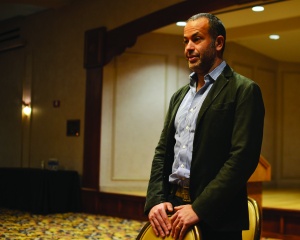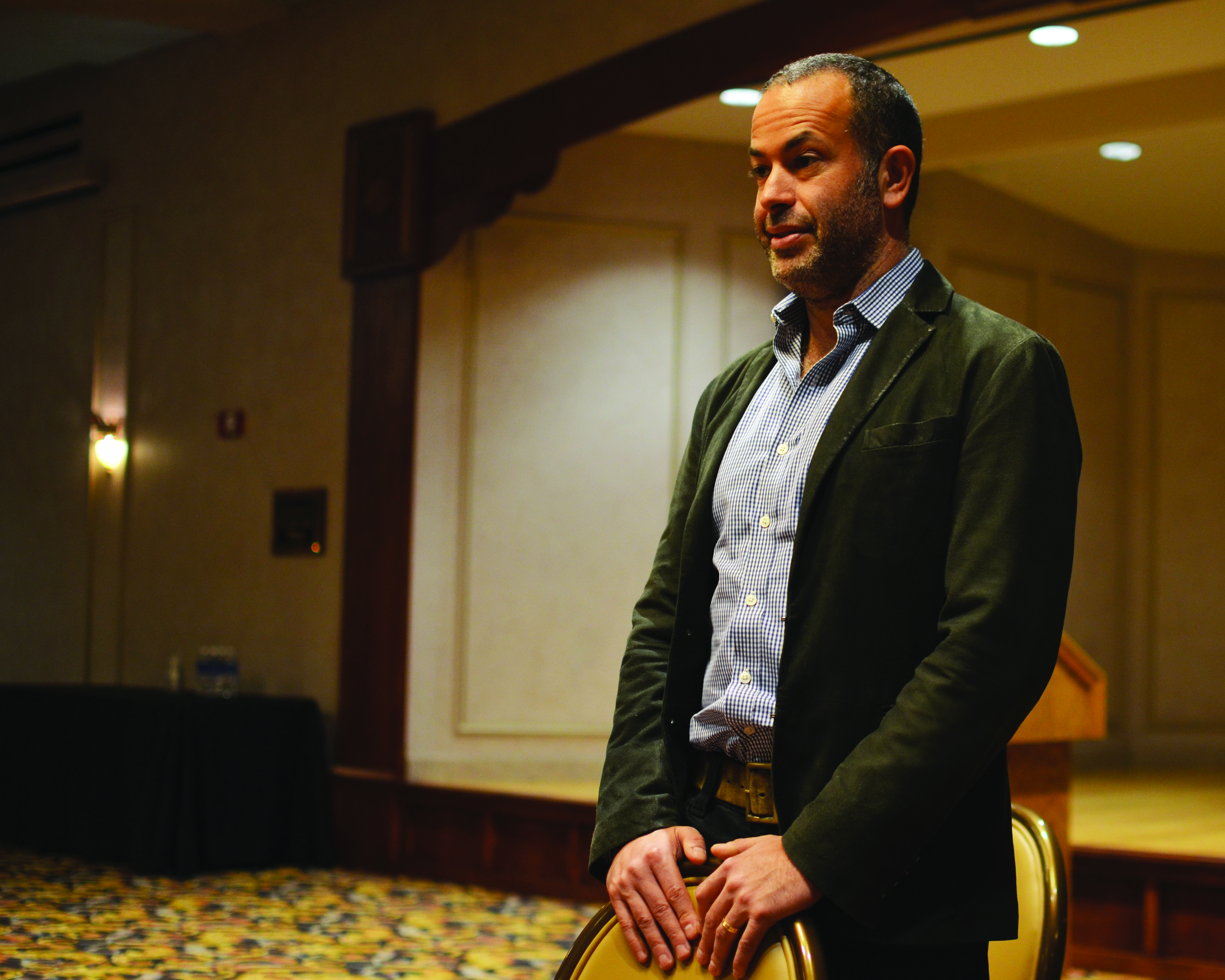By: Jake Myers

For many, a viral outbreak is the stuff of nightmares. For Nathan Wolfe, professor of human biology at Stanford University, they’re the reason he gets up in the morning.
Known as the “Indiana Jones” of virus hunting, Wolfe spoke Thursday as a part of the Skeggs Lecture Series. Approximately 600 people attended his lecture at Stambaugh Auditorium.
Wolfe is founder and CEO of Metabiota, a for-profit company specializing in microbiological research, products and services. He is also the founder of Global Viral, whose mission is to promote understanding, exploration and stewardship of the microbial world.
“I teach an occasional undergraduate seminar, but I spend most of my time running a company called Metabiota, which I founded in 2008, and then I am helping to lead a nonprofit called Global Viral,” Wolfe said. “I don’t have the same opportunities to be engaged in academia so I just kind of do these things every once in a while … I do maybe four or five of these a year.”
Wolfe started off his lecture by explaining the importance of Dr. John Snow to the field of epidemiology.
Epidemiology is the branch of medicine that deals with the incidence, distribution and possible control of diseases and other factors relating to health.
Snow was responsible for creating the “ghost map,” which showed the outbreaks of cholera in London in 1854. According to Wolfe, this was the “first sort of geographic information system.”
Unlike the common consensus at the time, which was that diseases were transmitted through the air, Snow surmised that the cholera moved through water. He removed the handle on the well that he believed to be infected and eventually stopped the transmission of the disease.
Wolfe went on to discuss how the interconnectedness of the world puts us at greater, more intense risks.
“A virus that emerges from central Africa has the potential to traverse the planet in no time,” Wolfe said.
Other topics that Wolfe touched upon were risks from terrorist attacks using microorganisms, such as a recent incident where anthrax was released from a high-rise building. He also said there are risks to storing frozen viruses. For example, a virus from the 1950s caused an outbreak in the 1970s due to some sort of lab incident.
“This was an exclusive risk that was never faced as a population before,” Wolfe said.
Wolfe said that the reason we were able to determine that the virus was the same was because of our capacity to sequence genetic information.
“We were given this wonderful sort of gift in biology that all of the things we know about the planet, every form of life that exists out there, uses basically one kind of code, and this miracle of course is DNA,” Wolfe said.
Wolfe has initiated a program that educates bush people on how to identify which animals are likely to carry viruses.
In areas with primitive or less developed societies that live alongside animals which are likely to carry viruses, members of the indigenous societies will take blood samples from these animals. They then place their blood on filter paper, which is then sent to be tested for viruses. If positive, the samples undergo genetic sequencing.
Although fieldwork has its downside, Wolfe sees it as a necessity to identify risks.
“One of the great things we have found about working around the world is that there is never a place that we worked, no matter what level of resources are present, where we can’t find great scientists who are really engaged in working on these kinds of problems,” Wolfe said.
One of Wolfe’s major reasons for lecturing is to get future generations interested in the field.
“I would say part of me doing a talk here at Youngstown State University is that I think it is very important for the next generation of scientists to engage in microbiology,” Wolfe said. “I think it is a fascinating subject that has technology now that permits us to really understand it, and the risks for these epidemics are very high, so part of it for me is to interface with the next generation of scientists and to encourage people to explore interest in this area.”
This was evident with the amount of time he spent with YSU students and guests, according to Jackie LeViseur, director of university events at YSU.
“Dr. Wolfe was very gracious, kind and very approachable,” LeViseur said. “He really took the time to talk to everyone at the event, especially our students, and gave them a once in a lifetime opportunity to interact with a scientist of such renown.”
In the afternoon, prior to the lecture, Wolfe met with a small group of students.
After the lecture, he held a question and answers session and then rounded out the evening with a book signing.
“It was truly a pleasure to have him here,” LeViseur said. “Dr. Wolfe’s manner was the same at the book signing; he spent as much time with guests as they wanted, answered questions and took photos with them.”
Topics covered during the Q-and-A session included Lake Erie blue-green algae, which lead to a discussion of “global viral mixing” and the “lost diversity of amphibians.”
Subjects also included divergent organisms, such as influenza, and the need for a universal influenza vaccine.
During the Q-and-A, Wolfe professed that cyanobacteria, a photosynthetic bacteria, is his favorite microbe.
When asked what the biggest public health misstep in Wolfe’s lifetime was, he cited that it was when public health officials came out after the HIV epidemic and announced that we would have a vaccine within a year.
There is still no vaccine for HIV.
Although Wolfe denies that his job is as “sexy” as that of Indiana Jones, he and his companies are the first line of defense against deadly viruses.
“You don’t even seem to be aware of the severity of risk to you and your livestock populations, or even the wildlife around you faces, as the consequences of globalization and the interconnectivity of animals including humans on the planet,” Wolfe said. “I think he [John Snow] would be scared; I think all of us would be scared.”

